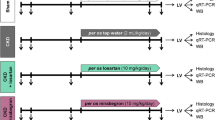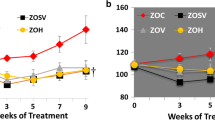Abstract
Puromycin-induced nephrotic syndrome is an animal model of progressive renal disease. Both angiotensin converting enzyme inhibitors and lipid-lowering agents have been used to preserve renal structure and function in this model, although neither completely prevents progression. We tested the hypothesis that the combination of the two agents would be more protective than either alone. Rats were divided into five groups; all were uninephrectomized. Four groups were given puromycin at a dose of 10 mg/100 g body weight (BW) with additional doses of 4 mg/100 g BW given intraperitoneally at 4, 5, and 6 weeks thereafter. One group was given enalapril (EN) 50 mg/l dissolved in the drinking water; the second received lovastatin (L) 15 mg/kg given daily by gavage; the third received both agents; the fourth was left untreated, and the final group received no puromycin and served as the control group. Eight weeks after the initial dose of puromycin, glomerular filtration rate (GFR), as inulin clearance, and protein excretion were determined and blood was collected for cholesterol and triglycerides. Blood pressure was not different between any of the groups. At the end of the study period, serum cholesterol [mean ±SD, 252±185 mg/dl (L), 135±101 mg/dl (L+EN)] and triglycerides (239±200, 148±158 mg/dl) were significantly lower (P<0.001) in the lovastatintreated groups than in the untreated puromycin group (535±255 mg/dl and 579±561 mg/dl, cholesterol and triglyceride, respectively). Likewise protein excretion was significantly lower (P<0.001) in these groups also [507±336 (L), 253±331 (L+EN) vs. 745±381 (puromycin) mg/24 h]. Renal function was also preserved with a significantly better GFR per gram kidney weight in the lovastatin-treated groups [0.56±0.33 (L), 0.54±0.19 (L+EN) vs. 0.17±0.11 ml/min per gram]. Glomerulosclerosis, as measured by a sclerotic index, was also significantly less in the lovastatin plus enalapril-trated group (0.29±0.35) compared with the untreated puromycin group (2.29±0.54). Although enalapril had little effect by itself, the combination of enalapril and lovastatin appeared to significantly improve the decrease in serum cholesterol, triglyceride, and protein excretion. Thus treatment with lovastatin alone, and its subsequent lowering of serum cholesterol and triglyceride concentrations, improved renal structure and function in this model of puromycin nephrosis. The combination of lovastatin and enalapril resulted in the least histological damage, the least protein excretion, and preservation of GFR.
Similar content being viewed by others
References
Mitch WE, Stein JH (1992) Contemp Issues Nephrol 26: 1–277
Keane WF, Anderson S, Aurell M (1989) Angiotensin converting enzyme inhibitors and progressive renal insufficiency. ann Intern Med 111: 503–506
Anderson S, Rennke H, Brenner BM (1986) Therapeutic advantage of converting enzyme inhibitors in arresting progressive renal disease associated with systemic hypertension in the rat. J Clin Invest 77: 1993–1997
Zatz R, Dunn BR, Meyer TW, Anderson S, Rennke HG, Brenner BM (1986) Prevention of diabetic glomerulopathy by pharmacological amelioration of glomerular capillary hypertension. J Clin Invest 77: 1925–1930
Anderson S, Diamond JR, Karnovsky MJ, Brenner BM (1988) Mechanisms underlying transition from active glomerular injury to late glomerular sclerosis in a rat model of nephrotic syndrome. J Clin Invest 82: 1757–1768
Kamper AL, Strandgaard S, Leyssac PP (1992) Effect of enalapril on the progression of chronic renal failure. Am J Hypertens 5: 423–430
Kasiske BL, O'Donnell MP, Schmitz PG, Kin Y, Keane WF (1990) Renal injury of diet-induced hypercholesterolemia in rats. Kidney Int 37: 880–891
Kasiske BL, O'Donnell MP, Cleary MP, Keane WF (1988) Treatment of hyperlipidemia reduces glomerular injury in obese Zucker rats. Kidney Int 3: 667–672
Harris KP, Purkerson ML, Yates J, Klahr S (1990) Lovastatin ameliorates the development of glomerulosclerosis and uremia in experimental nephrotic syndrome. Am J Kidney Dis 15: 15–23
Fogo A, Yoshida Y, Glick AD, Homma T, Ishkawa I (1988) Serial micropuncture analysis of glomerular function in two rat models of glomerular sclerosis. J Clin Invest 82: 322–330
Raji L, Azar S, Keasne WF (1984) Mesangial immune injury, hypertension and progressive glomerular damage in Dahl rats. Kidney Int 26: 137–143
Smith H (1965) Principles of renal physiology. Oxford University Press, New York, pp 196–215
Diamond JR, Karnovsky MJ (1986) Focal and segmental glomerulosclerosis following a single intravenous dose of puromycin aminonucleoside. Am J Pathol 122: 481–487
Grond J, Weening JJ, Elema JD (1984) Glomerular sclerosis in nephrotic rats. Lab Invest 51: 277–285
Kasiske BL, O'Donnell MP, Garvis WJ, Keane WF (1988) Pharmacologic treatment of hyperlipidemia reduces glomerular injury in rat 5/6 nephrectomy model of chronic renal failure. Circ Res 62: 367–374
Marinides GN, Groggel GC, Cohen AH, Cook T, Baranowski RL, Westenfelder C, Border WA (1987) Failure of angiotesin converting enzyme inhibition to affect the course of chronic puromycin aminonucleoside nephropathy. Am J Pathol 129: 394–401
Marinides GN, Groggel GC, Cohen AH, Border WA (1990) Enalapril and low protein reverse chronic puromycin aminonucleoside nephropathy. Kidney Int 37: 749–757
Trachtman H, Zavilowitz B, Bennett B, Goldsmith DI (1985) The effect of captopril on urinary protein excretion in puromycin aminonucleoside nephrosis in rats. Pediatr Res 19: 823–834
Trachtman H, Del Pizzo R, Valderrama E, Gauthier B (1990) The renal functional and structural consequences of corticosteroid and angiotensin-converting enzyme inhibitor therapy in chronic puromycin aminonucleoside nephropathy. Pediatr Nephrol 4: 501–504
Andreoli SP (1993) Captopril scavenges hydrogen peroxide and reduces, but does not eliminate, oxidant-induced cell injury. Am J Physiol 264: F120-F127
Kasiske BL, O'Donnell MP, Cleary MP, Keane WF (1989) Effects of reduced renal mass on tissue lipids and renal injury in hyperlipidemic rats. Kidney Int 35: 40–47
Diamond JR, Karnovsky MJ (1987) Exacerbation of chronic aminonucleoside nephrosis by dietary cholesterol supplementation. Kidney Int 32: 671–677
O'Donnell MP, Kasiske BL, Kin Y, Atluru D, Keane WF (1993) Lovastatin inhibits proliferation of rat mesangial cells. J Clin Invest 91: 83–87
Author information
Authors and Affiliations
Rights and permissions
About this article
Cite this article
Brouhard, B.H., Takamori, H., Satoh, S. et al. The combination of lovastatin and enalapril in a model of progressive renal disease. Pediatr Nephrol 8, 436–440 (1994). https://doi.org/10.1007/BF00856524
Received:
Revised:
Accepted:
Issue Date:
DOI: https://doi.org/10.1007/BF00856524




